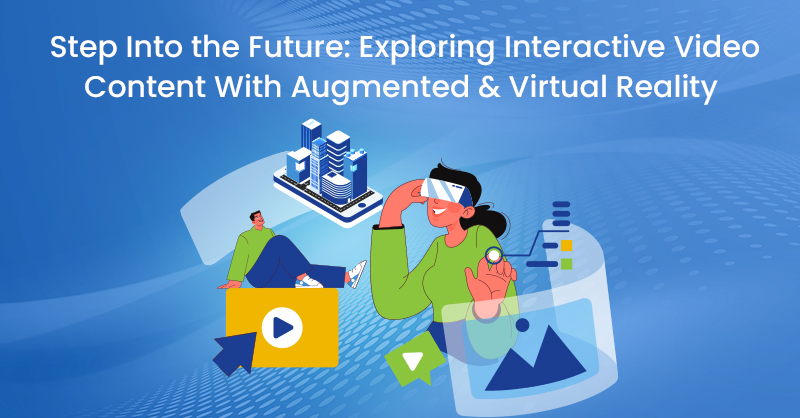Video content has undergone a remarkable evolution! It has become increasingly interactive, with viewers demanding more engaging and immersive experiences.
The new era of digital technology has paved the way for innovative formats that blur the lines between content consumption and active participation. With the advent of augmented and virtual reality, video content today has the potential to be a very interactive experience rather than a traditional, linear one.
In this infographic, we’ll be exploring essential aspects of augmented and virtual reality, including what they are, their impact on customer experience, how they’re revolutionizing different industries, the challenges to be expected and what they hold for the future. By the end, you will gain a comprehensive understanding of how this transformative technology is redefining viewer engagement and shaping the future of storytelling.
Understanding AR and VR
Augmented Reality (AR) and Virtual Reality (VR) are two technologies that are revolutionizing the way we interact with screens, introducing innovative and captivating interactive experiences.
Augmented Reality (AR) is an innovative technology that brings digital objects into the physical world. Anyone with a smartphone or tablet can access it with ease. AR allows users to visualize digital images in the real world with the help of applications that support cameras.
On the other hand, Virtual Reality (VR) allows you to leave the real world and enter a highly simulated virtual world. By using specially created sensors, headsets, and gloves, you can engage with this computer-generated world, interact with it in real-time, and experience a fully simulated 3D space as if you were physically present in it.
In short, AR enhances the real world by overlaying digital elements such as images, videos, or information. VR provides a completely immersive experience by creating a simulated environment that replaces the real world. While AR and VR are often grouped together, they represent distinct experiences. However, both technologies share the common goal of creating interactive and engaging experiences for users, pushing the boundaries of human-computer interaction.
The Impact of AR and VR on Customer Experience
Augmented and virtual reality have proven to be a huge game-changer for businesses across industries, especially when it comes to improving customer experience.
By overlaying digital information in the real world, AR creates enhanced, personalized user experiences that boost customer engagement. Furthermore, in the retail industry, AR enables virtual try-ons, product visualizations, and interactive store experiences. For example, IKEA’s Place app leverages AR to allow customers to see what certain furniture would like in their home. Sephora’s Virtual Artist, a feature in the beauty retailer’s iOS app, lets users apply virtual makeup at home with the help of AR as well.
With the advent of VR technology, an entirely new dimension of interaction has been created. Virtual reality offers an immersive experience where users can directly interact with the content, stimulating their senses. The British Museum, for instance, uses VR to take people on virtual tours through Google Street View. The virtual tours allow users to fully immerse themselves in the experience as they listen to Museum curators introduce galleries while moving from one exhibition to the next.
Without a doubt, AR and VR are doing more than just pushing the envelope in customer experience with their advanced technology. They are also helping brands foster a deep connection with their audience in the long run.
How AR and VR Are Revolutionizing Diverse Industries
AR and VR have significantly transformed various industries, such as education, marketing, entertainment, real estate, tourism, and more.
In the following section, we will explore how AR and VR have uniquely impacted each industry, examining specific examples and innovations that highlight their transformative effects.
In recent years, AR and VR have improved the education industry by creating an interactive experience for students. They allow students to take virtual field trips and labs, play engaging games and challenges, collaborate with each other and with virtual objects, and more. For example, the SkyView app gives students the opportunity to explore the universe, using AR overlays of the night sky. If you thought it couldn’t get more immersive than that, Microsoft HoloLens allows medical students and clinicians to learn about the human body through mixed reality!
With training, AR and VR can be used to develop training programs for companies to assess their employees and determine their overall competency for the job. As of last November, TD Bank has been using VR to create a virtual reality experience for employees as a part of their new training program. They have to respond to real-life scenarios in a virtual TD Bank, like dealing with stressed customers, allowing them to gain first-hand experience and become more familiar with the standard business practices.
-
Marketing and Advertising
AR and VR are transforming marketing and advertising by offering personalized experiences for customers.
AR allows consumers to virtually interact with products such as clothing, accessories, makeup, food, drinks, and so forth, by using their smartphone cameras, creating a deeper connection with the brand. AR also provides enhanced product visualization through allowing customers to visualize how a product will look in their environment.
Last year, Coca-Cola Zero Sugar released its first augmented reality giveaway campaign in the UK and invited consumers to “#TakeATasteNow”. Consumers could interact with and change AR visuals on a huge screen through their phones. They also had to scan a QR code to get a digital bottle of Coca-Cola Zero Sugar along with a voucher, allowing them to claim the actual drink in stores. The campaign drove product discovery and uptake, but more importantly, it created a memorable experience for consumers.
VR allows customers to explore products and services in a simulated virtual reality landscape. By doing so, it helps brands offer personalized content that resonates with each user. This level of customization can enhance the effectiveness of marketing campaigns and improve customer satisfaction. In addition, VR interactions can be tracked and analyzed, which helps marketers use these insights to refine their strategies and optimize content.
Back in 2021, North Face created a VR campaign after launching their mountain-inspired city collection. Since it was released during the height of the pandemic when lockdowns were in effect, this virtual reality experience allowed users to explore breathtaking mountain peaks in Europe, including the French Alps and Mont Blanc.
AR and VR technology could be utilized in the field of entertainment in many different ways. For instance, live virtual events, like festivals and concerts, create new avenues of interaction between the viewer and the content. The use of AR has been shown to expand the number of festival-goers by 67% and there has been an increase in the number of people willing to pay for a VR concert by 77%. Last year, 21 Pilots’ virtual concert was brought to life in the Roblox Metaverse and it attracted an estimated 33 million visitors.
When we think of AR in the gaming field, the first thing that might pop up in most people’s minds is Pokémon GO. This game has blended the real and virtual worlds to create a virtual reality landscape and make the experience more engaging for users. Other games like escape rooms and mystery-solving puzzles also use AR/VR technology to help people solve them in a more interactive manner.
When it comes to real estate, AR/VR allows real estate agents to show prospective clients a property without them physically being there. With augmented reality, homebuyers can overlay digital information in their physical surroundings, like furniture arrangements or colour schemes, to envision how the space would look like. VR enables them to go on virtual property tours for specific homes and explore them in a more simulated environment. These technologies have definitely made buying property easier and broadened the market reach for real estate agents.
In the field of tourism, AR and VR has allowed people to travel all over the world to experience new countries, cities, museums and restaurants while still being within the comfort of their own home. Let’s take Visit Wales as an example. The company shows the sights and sounds of Wales by leveraging VR tourism and 360 degree photography. This gives users a taste of various locations, from museums and countrysides to castles and courtyards.
Challenges and Considerations in AR and VR
Even though AR and VR have significant benefits in different sectors, they also have some potential challenges that should be taken into consideration.
One main barrier is that AR and VR are powered by very advanced technology, which makes using them very expensive. Most companies might not have the budget to invest in AR/VR, so they will be unable to gain access to it.
Another drawback of using AR and VR is that they can potentially malfunction. All technological tools and devices are prone to issues and they often occur without warning. If you experience technical problems with using AR and VR for your business, it can hinder your operations by delaying output or affecting the performance of your marketing campaign.
It is also important to limit constant exposure to AR and VR. These technologies require users to pay attention to certain virtual objects or worlds on a digital screen with a high level of concentration. While that may sound harmless, when this is done for a prolonged period of time, it might affect our health, causing headaches and eye strain.
Lastly, an ethical concern to keep in mind while using AR and VR is privacy. AR and VR technologies are involved in collecting users’ personal information. For this reason, it’s important to be mindful of the ways these technologies can utilize your data before deciding whether to commit to using AR/VR.
The Future of Video Content
Both AR and VR offer exciting possibilities for video content. According to recent trends, it seems like there will be more marketers, advertisers, as well as businesses, that want to provide distinctive and exciting services for their customers by leveraging this technology.
Due to the expansion of AR/VR, videos are expected to become increasingly interactive. In the world of eCommerce, shoppable videos will develop into an essential element in digital marketing strategies that many brands can rely on. These videos are an interactive form of media that allows consumers to directly interact with products, while making real-time purchases. In the past, brands found it a challenge to get shoppable videos off the ground, but with the power of AR and VR, things will be changing for the better sooner rather than later.
As video-sharing platforms develop over time, user-generated stories featuring AR will enhance personalization and become a more important part of every online marketing strategy. According to the Medium, 200 million users are engaging with AR content every day on Snapchat and at least 600 million are doing so every month on Facebook and Instagram. AR lenses and filters, like Lens Studio (by Snap) and Spark (by Facebook), has led many creators to easily use these tools from their smartphones when creating content, opening the door to UGC for AR—and this is just the beginning.
It can’t be denied that the progress of AR and VR technologies creates exciting opportunities for immersive audio-visual experiences, allowing businesses to provide exceptional user interactions.
Embracing the Next Wave of Digital Transformation Through AR and VR
In conclusion, AR and VR are at the forefront of the next evolution in video content by driving a shift towards more interactive, immersive, and personalized experiences. These technologies have revolutionized the way we interact with and consume digital media, offering unprecedented levels of engagement and immersion.
As we move forward, AR and VR are set to redefine storytelling and impact numerous industries, creating more personalized and interactive experiences. While the adoption of these technologies comes with their own set of challenges, the potential of AR and VR far outweigh the drawbacks. It promises a future where interactive video content becomes the norm rather than the exception.
As businesses and content creators continue to explore and harness the capabilities of AR and VR, we can expect to see more innovative and engaging video content that captivates audiences and enhances user experiences. Embracing these technologies will be key for businesses looking to stay ahead in the digital landscape and deliver exceptional value to their customers. The future of video content is here, and it is more exciting than ever.
Are you ready to step into the future of video content creation? At TechWyse Internet Marketing, we can help your brand with our top-grade Video Marketing Services. Let’s collaborate to create professional video content that engages, informs, and inspires your target audience. Call 866-208-3095 or contact us here today to explore the possibilities!





